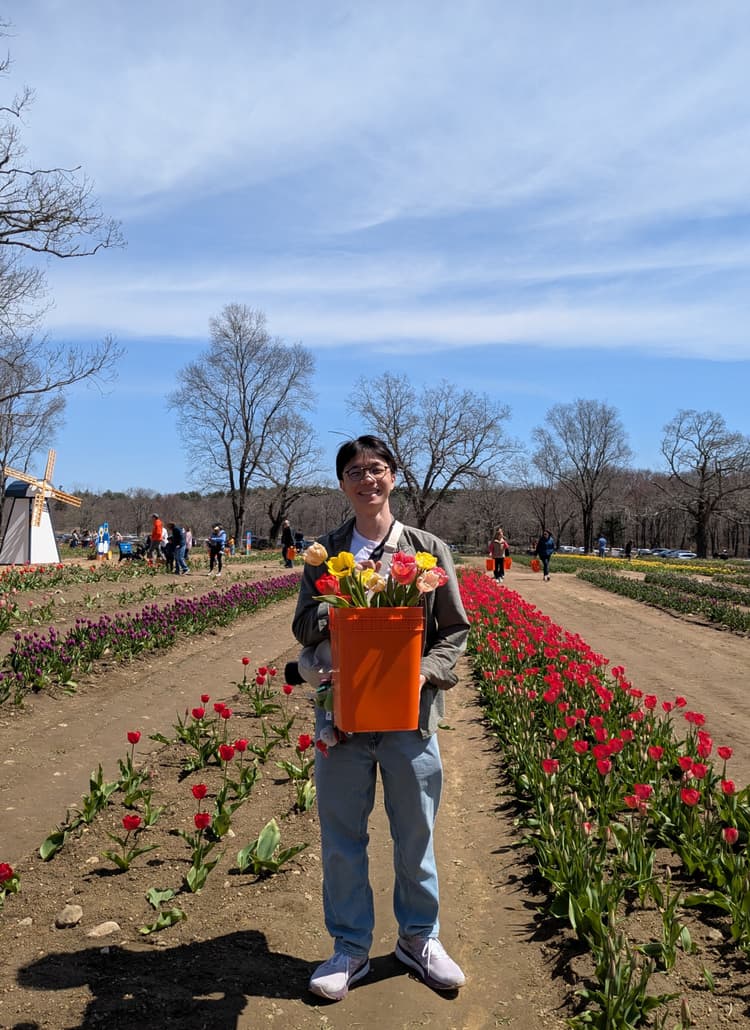KYLE LAM
is a software engineer focused on creating platforms that make | easier.
CS & Biochemistry from Brown University
About Me
I'm Kyle Lam — I build systems that make data-driven research faster, smarter, and more scalable.
Originally from Southern California, I recently graduated from Brown University having studied my "ABCs": Applied Math, Biochemistry, and Computer Science.
I’m especially interested in the spaces where research meets real-world engineering — whether that’s training large-scale ML models, designing scientific software, or building infrastructure for high-throughput bioinformatics data workflows.
Outside of work, I practice Taekwondo, take interesting pictures, and love to test new recipes and food. If you have any, send them my way!
Software Engineering Intern
Brown University's Center for Computation and Visualization

Flower picking at a tulip field in Exeter, RI!
Experience
Software Engineering Intern • Center for Computation and Visualization
TL;DR:
Full-stackDevOpsLLM-opsObservability- •Built and deployed a full-stack dashboard using React, Node.js, FastAPI, and MongoDB to streamline the management of bioinformatics data pipelines.
- •Designed and implemented a CI/CD pipeline with Docker and GitHub Actions for faster and more reliable deployments.
- •Integrated a large language model to automate schema generation and improved developer experience with standardized environments and automated testing.
Machine Learning Undegraduate Researcher • Balestriero Lab, Brown University
TL;DR:
Self-Supervised LearningComputer VisionML InfrastructureHPC / Slurm- •Designed machine learning experiments to study how data augmentations influence model bias in self-supervised vision models.
- •Developed training infrastructure and contributed to open-source libraries using PyTorch.
- •Engineered distributed training scripts for large-scale experiments on HPC clusters, streamlining setup and job scheduling with Slurm.
Undergraduate Teaching Assistant • Department of Computer Science, Brown University
TL;DR:
Course DevelopmentAI SafetyDeep LearningProject Mentorship- •Led course development, project design, and student support for both a small seminar on AI & Security and a large lecture course on Deep Learning.
- •Collaborated with faculty to develop assignments on cryptography, AI safety, and neural networks.
- •Provided mentorship to student teams applying deep learning in domains like music, genomics, and art.
Computational Physics Undergraduate Researcher • Martiniani Lab, NYU
TL;DR:
Monte Carlo SimulationComputational PhysicsMonte Carlo AlgorithmsScientific Visualization- •Implemented and optimized Monte Carlo simulation algorithms in Python and C++ to study complex particle systems.
- •Worked closely with postdocs and faculty on algorithm design, performance tuning, and real-time data visualization.
- •Presented research and software at the NYU Summer Research Symposium under the NYU Computational Physical Chemistry SURP.
Computational Biophysics Undergraduate Researcher • Rubenstein Group, Brown University
TL;DR:
BioinformaticsMolecular DynamicsHPC / GROMACS / WESTPA- •Built modular bioinformatics pipelines in Python to analyze protein sequence and structural data, with significant performance improvements over existing tools.
- •Automated molecular dynamics simulations using GROMACS and WESTPA on HPC clusters to study conformational dynamics in Abl1 kinase mutants.
- •Co-authored a peer-reviewed preprint in eLife uncovering novel mechanistic insights into rare kinase states.
Featured Projects
Real-time ASL Classification
A deep learning approach to classify American Sign Language fingerspellings in real-time.
Semantic Cube
A database integration enabling natural language OLAP queries using prompt caching and LLMs for query parsing and documentation
Anomaly Detection of Falling Events
A comparison of XGBoost, KNN, and RandomForest classifiers for detecting anomalous fall events in elderly care homes.
3D Scene Reconstruction with Flexible Object Control
A modular data pipeline for SfM scene reconstruction to enable flexible object configurations
Interpretation of Audio Diffusion Trajectories
Understanding and defining interpretability in diffusion model trajectories in audio generation and synthesis applications.